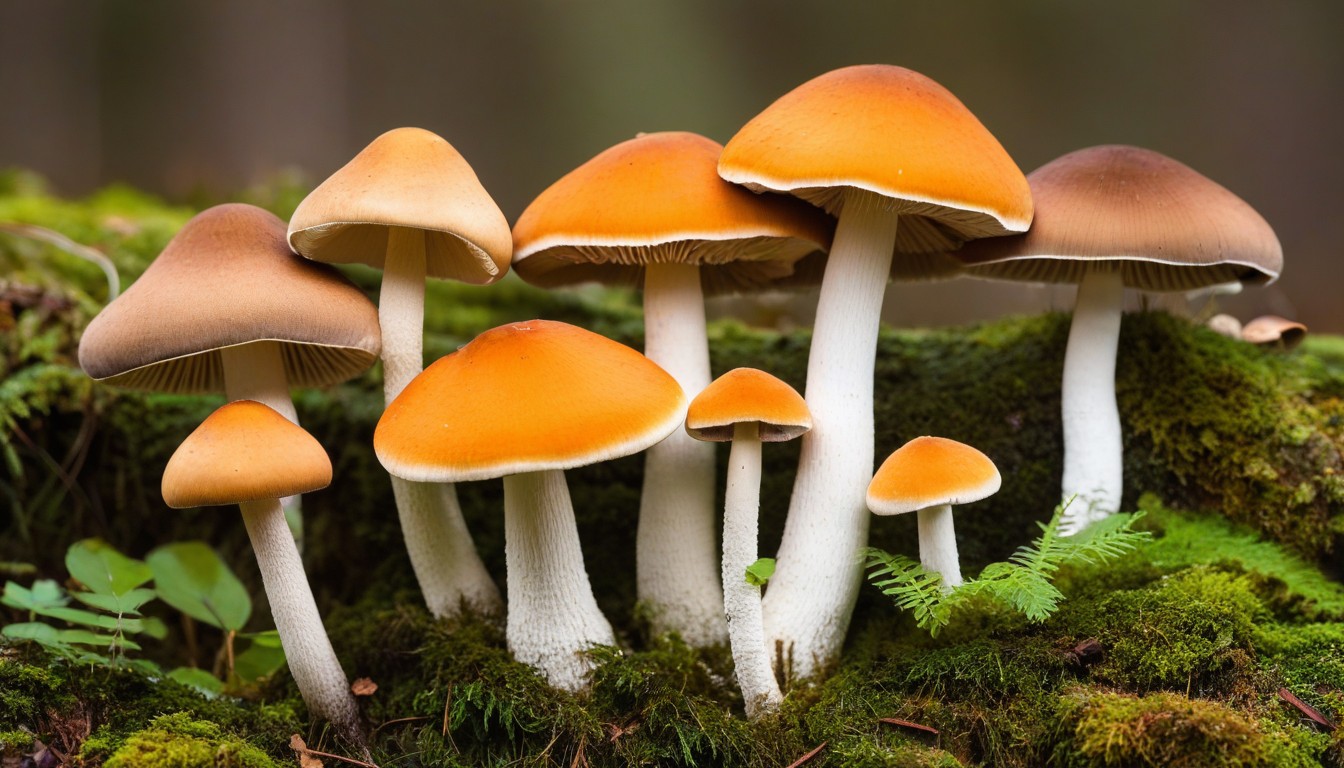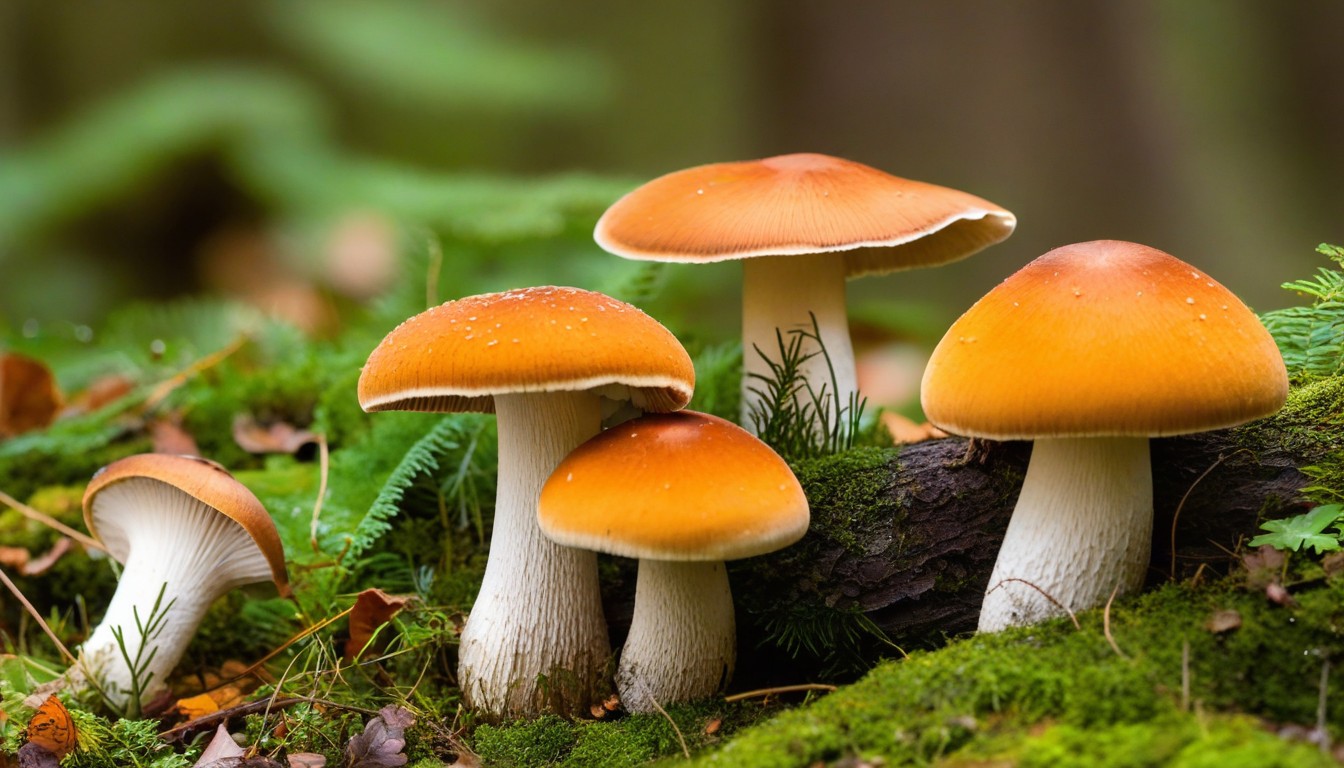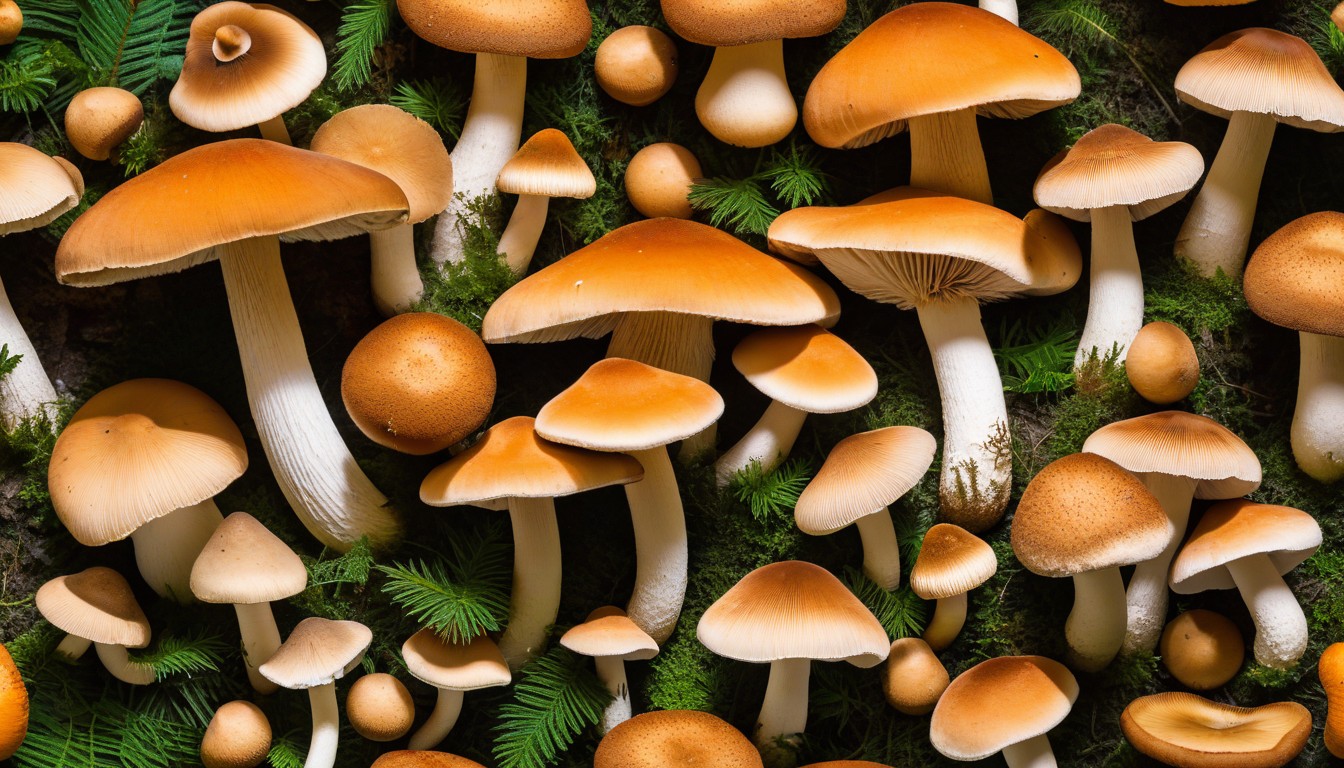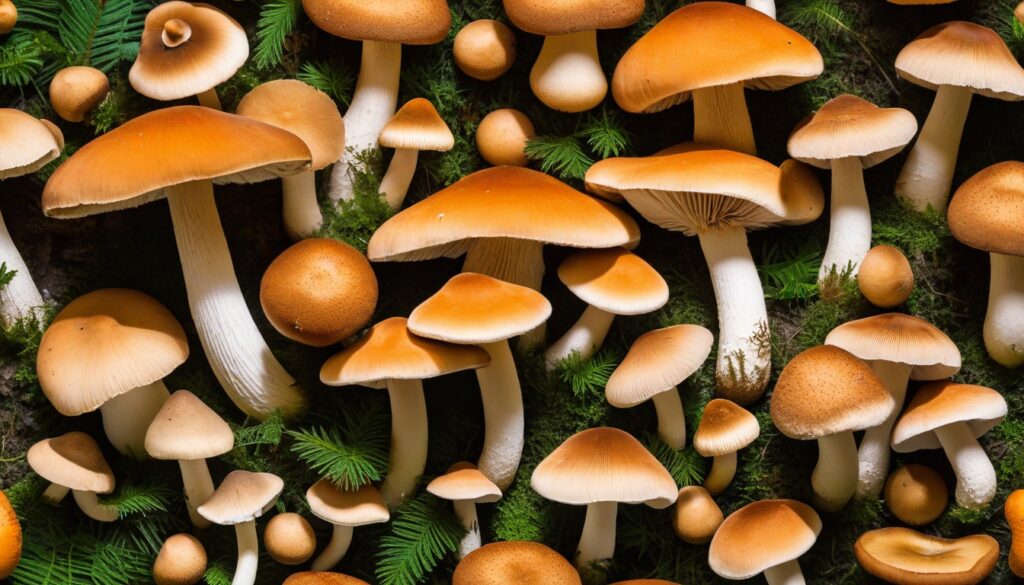Montana’s lush forests are home to a vast array of edible mushrooms waiting to be discovered. Whether you’re an avid forager or just starting, this guide will provide you with all the necessary knowledge to navigate the woods safely and find the best edible mushrooms.
Key Takeaways
- Montana is rich in various edible mushrooms, including morel mushrooms, chanterelle mushrooms, and porcini mushrooms.
- Knowing how to identify edible mushrooms and distinguish them from toxic ones is of paramount importance before starting your foraging adventure.
- Harvesting and cooking mushrooms requires proper techniques that guarantee both your safety and the sustainability of the local ecosystem.
- The best time to harvest mushrooms in Montana varies depending on the species and the environmental conditions, so it’s important to do your research beforehand.
- Learning about the best locations for mushroom foraging in Montana can save you time and energy on your foraging trip.
Understanding Edible Mushroom Basics
Embarking on a mushroom hunting journey can be an exciting adventure, but understanding the basics is essential to ensure your safety. Here are some critical points to keep in mind:
Mushroom Identification Techniques
Properly identifying edible mushrooms is crucial for a successful foraging experience. Check out resources such as field guides, online databases, and specific mushroom identification apps to help you recognize the various mushroom species. The more you learn and practice mushroom identification skills, the more confident you’ll become.
Foraging Safety Measures
When mushroom hunting in Montana, always put your safety first. Carry a map, stay alert, and dress appropriately for the occasion. Bring a partner and tell someone your whereabouts. While it’s rare to encounter dangerous wildlife, it doesn’t hurt to research and understand the local wildlife and take precautions accordingly.
Importance of Properly Identifying Edible Mushrooms
Due to the potential health risks associated with consuming poisonous mushrooms, properly identifying edible mushrooms cannot be overemphasized. Scrupulous identification is necessary to avoid life-threatening toxic mushrooms. Reliable resources, such as books or experienced mushroom hunters, can be incredibly helpful in identifying mushrooms safely.
Popular Edible Mushrooms Found in Montana
Few things are more satisfying than incorporating fresh, wild mushrooms into your favorite meals. Montana is a prime location for foraging for a variety of delicious mushrooms, ranging from the coveted morel mushroom to the meaty porcini mushroom. Below, we’ve compiled a list of the most popular edible mushrooms found in Montana:
|
Mushroom Name |
Description |
Flavor Profile |
|---|---|---|
|
A prized mushroom with a cone-shaped cap and a honeycomb-like texture. |
Nutty, with a meaty texture | |
|
A delicate mushroom with a trumpet-shaped cap and a yellow-orange color. |
Peppery, with a fruity aroma | |
|
Porcini Mushroom |
A firm, meaty mushroom with a thick, brown stem and a large, round cap. |
Elegant, with an earthy flavor |
|
Hen of the Woods Mushroom |
A large, fan-shaped mushroom with frilly edges and a soft texture. |
Umami, with a slightly sweet flavor |
|
Black Trumpet Mushroom |
A small, funnel-shaped mushroom with a blackish-brown color. |
Earthy, with a smoky flavor |
Remember to properly identify mushrooms before consuming them and always forage in a safe and responsible manner. Happy hunting!
Best Foraging Locations in Montana

If you’re looking to experience mushroom foraging in Montana, there are several locations worth exploring.
Glacier National Park
This iconic national park is a prime location for mushroom hunting, particularly from late August to early October when the forest floor is abundant with edible mushrooms. Be sure to check with park officials for any restrictions on foraging within the park.
Lolo National Forest
With over 3 million acres of forest, there are many opportunities to find edible mushrooms in Lolo National Forest. Look for mushrooms growing under pine, fir, and birch trees.
Bitterroot National Forest
The rich mix of plant life in Bitterroot National Forest makes it an excellent location for mushroom foraging in Montana. From morels to chanterelles, the forest offers a wide variety of edible mushrooms to discover.
Flathead National Forest
Famous for its huckleberries, Flathead National Forest is also an excellent location for fungi foragers. Hunt for mushrooms on the forest floor beneath Douglas fir and lodgepole pine trees.
Always check with local authorities for regulations and restrictions before embarking on any mushroom foraging excursions.
Seasonality and Habitat Preferences
Edible mushrooms in Montana have specific seasonal and environmental preferences that are important to understand when foraging. Knowing when and where to search for mushrooms can greatly increase your chances of finding a plentiful harvest.
Mushroom Seasons in Montana
Montana has a diverse climate that affects the growth and seasonality of edible mushrooms. Generally, spring and fall are the optimal times for foraging. Morels, one of the most sought after edible mushrooms, can be found in late spring, usually from April to early June, while chanterelles, another popular variety, fruits in late summer and early fall. Make sure to check the weather and temperature before heading out, as a sudden change can affect the timing of mushroom growth.
Mushroom Habitat
Mushrooms grow in specific habitats, depending on their species. For example, morels are often found at the base of cottonwood trees, while chanterelles prefer moist, mossy areas. Knowing the preferred habitat of a particular mushroom can help you narrow down your search and maximize your success. Some common mushroom habitats in Montana include coniferous forests, hardwood forests, and open meadows.
|
Mushroom |
Season |
Habitat |
|---|---|---|
|
Morels |
Spring |
Under cottonwood trees |
|
Chanterelles |
Summer/Fall |
Moist, mossy areas |
|
Porcini |
Summer/Fall |
Coniferous forests |
Remember to always respect the natural environment and practice sustainable foraging practices. Only take what you need and avoid damaging the ecosystem. With a little knowledge and a keen eye, you can enjoy the delicious flavors of Montana’s edible mushrooms in a responsible and ethical manner.
Proper Mushroom Harvesting Techniques

Harvesting edible mushrooms is an exhilarating experience, but it’s essential to follow proper techniques to ensure their sustainability. Here are some guidelines to keep in mind while foraging:
- Bring a basket or mesh bag to carry your mushrooms, allowing spores to spread as you move through the forest and ensure growth of new fungi in future foraging. Avoid plastic bags, which can cause mushrooms to sweat and spoil quickly.
- Only harvest mushrooms that you can properly identify as safe and edible. Learn the unique features of each species and familiarize yourself with their look-alikes to avoid accidentally picking poisonous mushrooms.
- Use a knife or scissors to cut the mushrooms instead of pulling them from the ground, damaging the ecosystem and preventing regrowth. Cut the stem of the mushroom, leaving a portion behind to continue sprouting more mushrooms.
- Stick to the “Leave No Trace” principle and avoid damaging the environment while foraging. Lift leaves and foliage gently, disturbing the natural habitat as little as possible. Respect the flora and fauna around you and avoid crushing other plants and mushrooms.
- Don’t take more than you need and avoid over-harvesting a single area. Balance your harvest with the natural production and maturity of the mushrooms in the area. Leave behind small or immature mushrooms to allow them to grow fully and reproduce for future foraging.
Proper mushroom harvesting techniques don’t only guarantee your safety and the sustainability of your foraging practices but also ensure the longevity and health of the mushroom ecosystems. Respect the environment, and you’ll enjoy the bounty of Montana’s edible mushrooms for years to come.
Preparing and Cooking Edible Mushrooms

After a successful foraging trip, it’s time to transform your wild-harvested mushrooms into delicious meals. Here’s a simple guide to help you get started on mushroom preparation and cooking techniques:
Cleaning and Storing Mushrooms
Once you’ve collected your mushrooms, it’s essential to clean them properly. Brush off any dirt or debris with a soft-bristled brush or a damp cloth. Avoid washing them, as mushrooms absorb water and can become soggy. Store your mushrooms in a paper bag or wax paper, away from direct sunlight, and refrigerate them for later use.
Cooking Techniques
Edible mushrooms can be cooked in various ways, depending on your preference and the type of mushroom. Here are some common techniques:
- Sautéing: Heat a skillet over medium-high heat and add oil or butter. Add your cleaned mushrooms, season with salt and pepper, and cook for 3-5 minutes until they’re lightly browned.
- Baking: Preheat your oven to 375°F. Place your cleaned mushrooms on a baking sheet, drizzle with olive oil, and season with salt, pepper, and any herbs or spices of your choice. Bake for 10-15 minutes until they’re tender and golden brown.
- Grilling: Preheat your grill to medium-high heat. Brush your cleaned mushrooms with oil or butter and grill for 3-5 minutes on each side until they’re slightly charred. Season with salt, pepper, and any additional flavors, such as balsamic vinegar, garlic, or lemon juice.
Culinary Uses
Edible mushrooms are versatile ingredients that can enhance a wide range of dishes. Here are some ideas for using your foraged mushrooms:
- Add them to omelets, frittatas, or quiches for a savory breakfast dish.
- Use them as a pizza topping or in pasta dishes, such as mushroom stroganoff.
- Make mushroom soup or stew for a warming, comforting meal.
- Roast them with vegetables, such as potatoes, carrots, and onions.
With these tips on mushroom preparation, cooking techniques, and culinary uses, you’re ready to create delicious meals using your locally-sourced, wild-harvested mushrooms. So go ahead and experiment in the kitchen, and enjoy the unique flavors and textures of Montana’s edible mushrooms!
Potential Look-Alikes and Toxic Mushrooms

Foraging for wild mushrooms can be a rewarding experience, but it comes with risks. It’s essential to be aware of mushroom identification and potential toxicity to avoid endangering your health. Knowing how to differentiate between edible mushrooms and toxic species is crucial during your foraging adventures.
Some of the poisonous mushrooms you can find in Montana include the Death Cap, Destroying Angel, Jack-O’-Lantern, and False Morel. These mushrooms can be lethal, causing severe damage to your liver or nervous system, and should be avoided at all times.
Learning about common toxic look-alike mushrooms is equally essential because they can be easily confused with their edible counterparts. For example, the Fool’s Mushroom and the Stinking Dapperling look similar to popular edible mushrooms, but they can cause vomiting, stomach cramps, and other symptoms if ingested.
Therefore, it’s vital to rely on mushroom identification with confidence, even if it means spending extra time inspecting the mushroom’s physical characteristics. Some of the factors that can help differentiate between edible and poisonous mushrooms include smell, color, gill attachment, and spore print color.
Common Poisonous Mushrooms in Montana
|
Mushroom Name |
Toxicity Level |
Physical Characteristics |
|---|---|---|
|
Death Cap (Amanita phalloides) |
Lethal |
Green cap, white gills, and a bulbous stem with a skirt |
|
Destroying Angel (Amanita bisporigera) |
Lethal |
White cap, white gills, and a volva surrounding the stem |
|
Jack-O’-Lantern (Omphalotus olearius) |
Potentially lethal |
Orange-yellow cap with decurrent gills and a stem that bruises orange |
|
False Morel (Gyromitra esculenta) |
Toxic |
Brain-like cap and ridged stem |
Don’t let the fear of poisonous mushrooms keep you from enjoying the beauty of mushroom foraging in Montana. By following foraging safety measures and taking the time to identify mushrooms properly, you can safely enjoy the many benefits of this rewarding adventure.
Conclusion
We hope that this guide has provided you with valuable insights into the world of edible mushrooms in Montana. With our expert tips on mushroom identification, foraging safety, and harvesting techniques, you are now well-equipped to explore the state’s lush forests in search of these tasty treasures.
Remember to always practice sustainable foraging practices and proper mushroom identification to ensure your safety and the preservation of these valuable fungi. With a little knowledge and a lot of curiosity, you can uncover the beauty and flavors of Montana’s wild edible mushrooms.
Happy foraging!
FAQ
Can all mushrooms found in Montana be safely eaten?
No, not all mushrooms found in Montana are safe to eat. It is crucial to properly identify edible mushrooms and distinguish them from toxic species. Familiarize yourself with expert identification techniques and consult reliable field guides before consuming any wild mushrooms.
What are some popular edible mushrooms found in Montana?
Montana is home to a variety of popular edible mushrooms, including morel mushrooms, chanterelle mushrooms, and porcini mushrooms. These mushrooms are highly sought after for their unique flavors and culinary uses.
Where are the best locations for mushroom foraging in Montana?
Montana offers numerous prime locations for mushroom foraging. National forests, state parks, and meadows with diverse ecosystems are often the best places to find abundant edible mushrooms. Be sure to obtain proper permits and follow any regulations or restrictions in these areas.
When is the best time to go mushroom foraging in Montana?
The mushroom season in Montana varies depending on the species. Morel mushrooms are typically found in spring, while chanterelle mushrooms and porcini mushrooms can be found during the summer and fall. It is important to understand the specific seasonality of the mushrooms you’re interested in foraging.
How should I harvest edible mushrooms sustainably?
Sustainable mushroom harvesting is crucial for the preservation of mushroom populations and their ecosystems. When harvesting, gently cut mushrooms at the base, leaving the mycelium intact. Avoid overharvesting in a single area and refrain from disturbing the surrounding habitat.
What are some popular cooking techniques for edible mushrooms?
Edible mushrooms can be prepared and cooked in various ways to bring out their unique flavors. They can be sautéed, grilled, roasted, or added to soups, stews, pasta dishes, and risottos. Experiment with different techniques to enhance the taste and texture of the mushrooms.
How can I differentiate toxic mushrooms from edible ones?
It is essential to be able to distinguish toxic mushrooms from edible species when foraging. Educate yourself on the common poisonous mushrooms in Montana and learn to identify their key characteristics. If you have any doubts about a mushroom’s safety, always err on the side of caution and avoid consumption.

